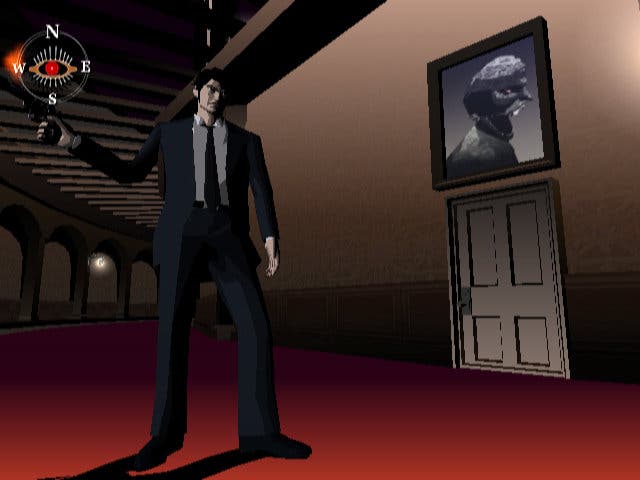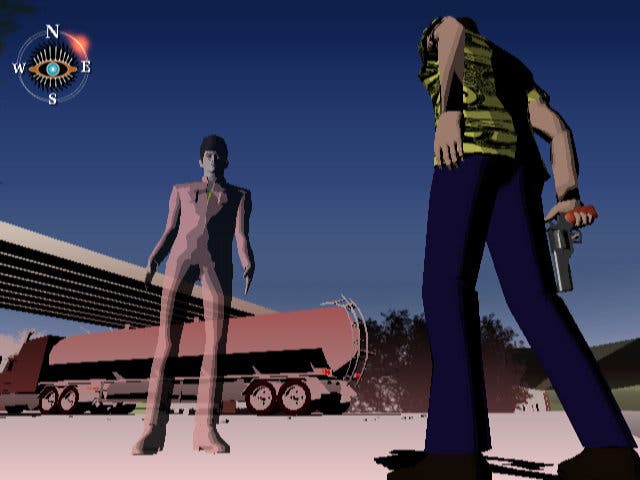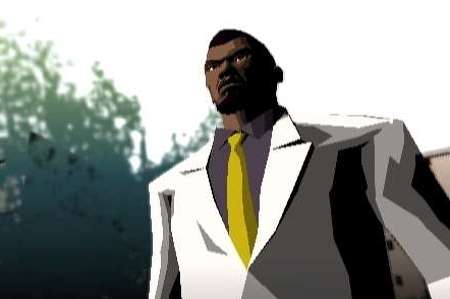Retrospective: Killer7
Try it, you might hate it.
"At best, playing the game is like having someone shout in your ear for 15 hours straight. At worst, it's like getting a high colonic with balsamic vinegar."
It's fair to say Stuff magazine weren't the biggest fans of Killer7, and they weren't the only ones. But aren't we always told the very best art is the most divisive? There's something quite wonderful about a game that can so polarise audiences, especially at a time where the vast majority of game developers have reached a level of coding competence such that the standard range of review scores rarely ventures outside the 6-9 bracket.
Games these days are safe. Nothing about Killer7 is safe.
"Style over substance" crowed the cynics before its release, perhaps partially because it was proving impossible to pigeonhole. Previews discussed its striking cel-shaded art at masturbatory length (with good reason: it's still incredibly stylish and beautiful) but writers often seemed as confused as their readers when it came to pinning down exactly what Killer7 was.

It didn't help that it had changed from its original form. Goichi Suda was one hell of an ideas man, but his earlier works hinted he was far less interested in mechanical depth or consistency. Sensibly, he was partnered with Shinji Mikami, and the more experienced of the two ventured that Suda's blend of puzzles and story - a bizarre tale of a wheelchair-bound assassin and his seven disparate, deadly personalities - was missing something: action.
This allowed writers to describe the game in terms of an abstract light-gun shooter, though even here Killer7 would ignore genre benchmarks. Rather than the game automatically switching to first person in the vicinity of enemies, you'd explore until you heard the unnerving cackle of the ghoulish Heaven Smile: zombie-like suicide bombers, all spindly limbs and horrible, twisted grins.
At that point you would have to plant your feet to commit to combat, holding the right shoulder button to aim and the left to scan for this invisible foe. That each should have a clearly defined weak point was the one true sop to convention, perhaps to compensate for the punishing difficulty level. Even that, however, wasn't to pass without a unique Suda spin, as the titular assassins each had their own speech sample to accompany a direct hit. Con Smith's vitriolic "f**k you" thus felt like a raised middle finger, an aggressive riposte to gaming's established tropes.
The element of danger lent an additional frisson to the exploration sequences. Buttressed by Masafumi Takada and Jun Fukuda's menacing score, these sections rippled with a nervy tension. A direct hit from an exploding Heaven Smile would result in death for the currently controlled assassin, who then had to be revived by the comparatively weak Garcian Smith, a mechanic recently echoed to anxiety-inducing effect in Demon's/Dark Souls' corpse retrieval. The upshot was a game that at times carried the tone and tenor of a survival horror, arguably more so than Mikami's own Resident Evil 4.

Away from the shooting, Killer7's control scheme proved equally divisive. Suda adopted a system designed to be reductively intuitive in order to focus attention on the narrative, but this streamlining ultimately felt disruptive. Pressing A to move forward and B to turn around might sound straightforward, but combined with the static - and often unusual - camera angles, it felt unnatural, serving mostly to heighten the sense of unease. Meanwhile doors, forks in the path and other key objects could be interacted with by pushing the analogue stick towards their indicator, triangular shards surely symbolic of its protagonist's fractured psyche.
Alfred Hitchcock once said of plot that, "an audience in confusion is not emoting". It's a lesson Suda evidently relished ignoring: here he revelled in the mad world he'd created, dotting his narrative with twisted vignettes and bizarre non-sequiturs from a whispering, gimp-suited helper. Piecing it all together often felt like attempting to complete a jigsaw puzzle whose pieces were constantly moving around and flipping over.
At least, it did for a long, long time. But as Killer7 approached its end, those narrative strands slowly began to knot together into one. By this time, many players would have long abandoned the game but those who stuck it out were treated to a bravura climax, spread across a couple of stages that forced you to re-evaluate everything you thought you knew.
It says a lot about Killer7 that one of its best bits involved running around collecting and listening to a selection of audio logs. It's a task that can be unimaginably tedious in almost every other game, but here it's genuinely exciting.

It's not just because it's at this very point that you're tantalised with the possibility of getting an answer to all your questions, but coupled with the tension of the situation, and the clandestine nature of your search, it feels as if you're uncovering some dark, important and long-buried secret rather than just following a breadcrumb trail. It would be easy to put that down to the game's stubborn refusal to spell anything out, but it's also down to Suda's writing craft and a sense of pacing that Hitchcock might well admire, even if he might tut at all that pesky weirdness.
And just as everything seemed to come together, the world collapsed in on itself thanks to a startling and sobering revelation. In other hands, this could easily have come across as a cheap parlour trick, but Suda turned it into a walloping gut-punch, particularly during one extended sequence that suddenly rendered you entirely powerless. There's something so exquisitely sad about the way everything dismantled in front of your disbelieving eyes that, as one character collapsed into tears, I felt almost as drained as they evidently were. Perhaps it is possible to be baffled and emotionally satisfied at the same time.
Of course, it took a while to get there, and along the way there was plenty of stuff to baffle and delight in equal measure. For every tedious fetch-and-carry puzzle there was a genuinely inventive conundrum. For every brilliant boss battle (the anime-themed Handsome Men encounter remains burned into my frontal lobe) there was an artificially frustrating one (hello, Ayame Blackburn).
The story remains divisive, but even the game's sternest critics would have a hard time arguing against the ferocity of some of its cutscenes. Few could deny the power of the sequence where rival assassin Curtis confronted his former business partner Pedro, tossing his young daughter's head into his lap before gunning him down in cold blood. It remains one of the most shocking, brutal acts seen in any game.
Crucially, it didn't feel gratuitous, just daring. And therein lay the beauty of Killer7. From its angular art through its psychosexual undertones to its political machinations (the ending has been widely interpreted as a critique on US foreign policy) it was utterly fearless. Indeed, it was fearless to such a degree that you can't imagine anyone would agree to publish it these days. In a climate where games are focus-tested to the nth degree, something this wilfully oblique would surely never pass the approval process.
And that's what makes it important. So whether you find it to be as enjoyable as a vinegar colonic, or you fully embrace Suda's beautiful, dark, twisted fantasy, it's worth seeking out Killer7 to see on which side of the fence you fall.



